|
|
Post by newey on Oct 25, 2011 21:27:55 GMT -5
+1 for a nice tutorial and pictorial of doing the 4-wire conversion. Good stuff!
|
|
|
|
Post by 4real on Oct 25, 2011 21:33:01 GMT -5
No problem and thanks. Was not sure if there was anything on it here, let me know and I can copy that post to a separate post in some kind of reference section if you like.
|
|
|
|
Post by 4real on Oct 26, 2011 3:42:58 GMT -5
A glorious island spring day today, and everything cancelled at a moments notice...so this morning I did the rewire on the HB (see previous page) and played with the hex things a bit... 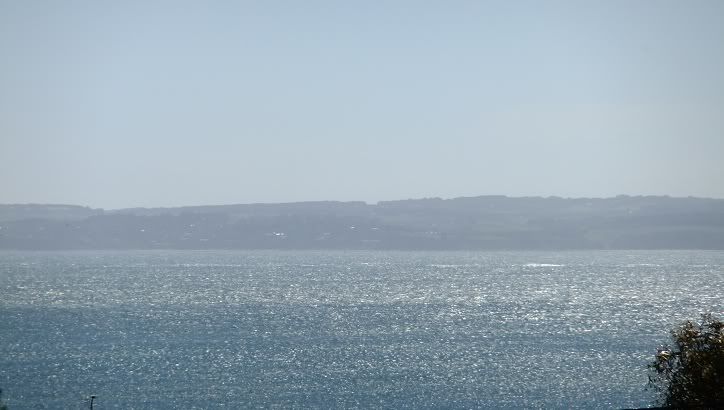 So, I realized it was the perfect weather for painting, up high out of the sun, not too windy, hot or humid...so took the thing apart and rubbed out any 'streaks' from the finish that was on it that I did years before when I stripped the body... 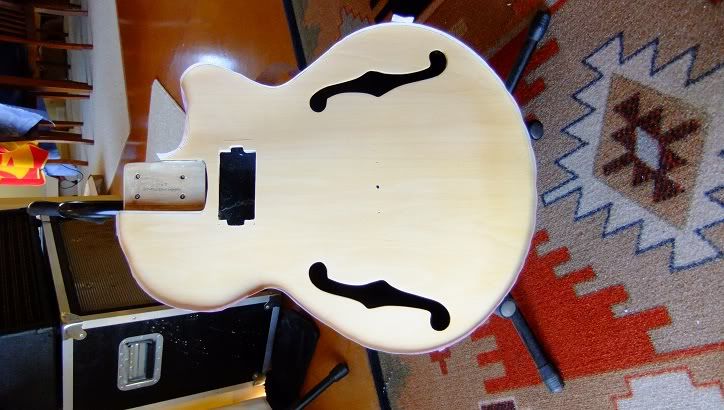 I taped up the edges and got the idea to tape the guitar to a guitar stand so a gust of wind didn't blow it over when wet and held nice and stable... 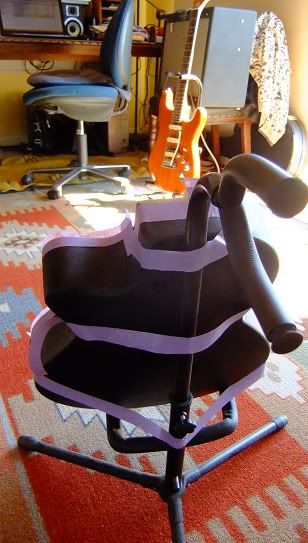 Once lightly sanded and taped, out into the sun...preparing the spray satin polyurethane that miraculously was still great since it was used on this in the past, turps, some containers, a small brush, paper towels and a foam brush and newspaper all set to go... 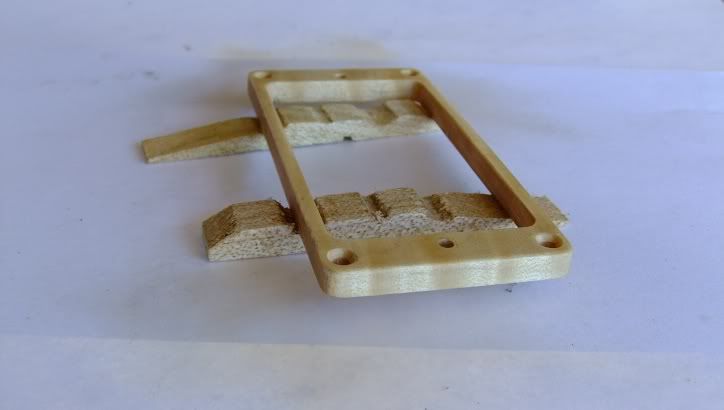 I started with the maple pickup ring...this had one coat so needed a bit more. I sanded it a bit and sprayed it, but I found that I needed to use the small brush and recoat the sides which have the end grain in them and soaks up a bit more. The "flame' in the maple is visible one finished in the sides... 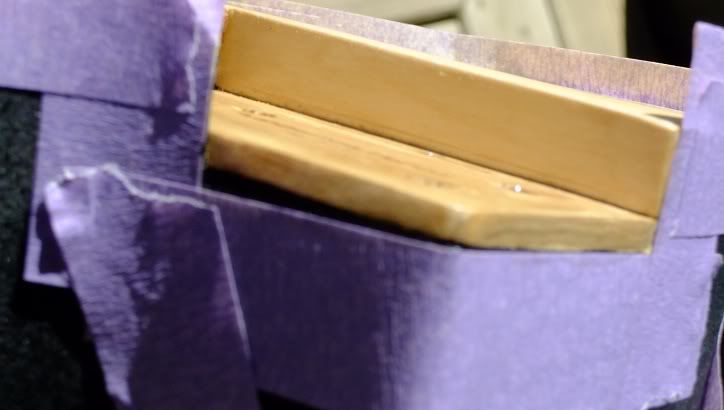 For the rebuilt neck join, I decided that I would use a permanent marker to black out the angle and leave the thickness of the 'moustrap' which is the same height as the binding visible. This had one coat from when I built it but would need some more, some bits of the neck join like the side shim had none at all. I again, sprayed into a container to get a bit of finish on the brush to do it carefully by nad and make sure it had a decent coat, especially on the raw wood parts. I did this also where I had made new holes or reinforced the top, such as the pickup ring hole... 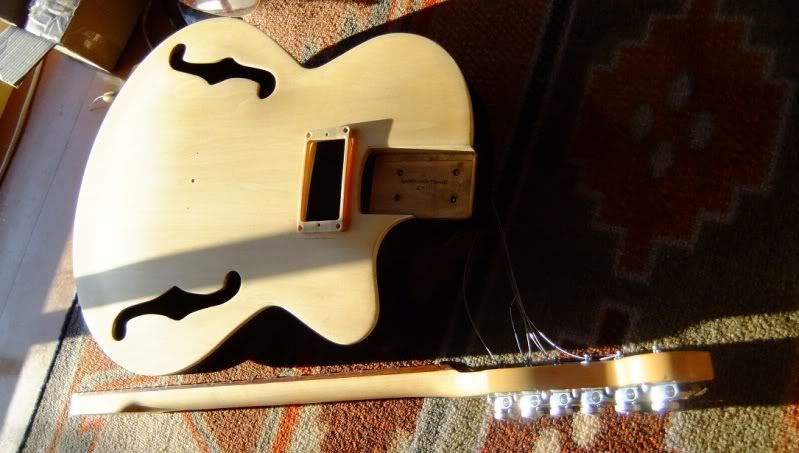 So...I sprayed it lightly, then using the foam brush with some turps on it, thinned things out and wiped it down to a thin streak free natural satin finish...making sure that there were no drips at the bottom in the tape (soaked up with a paper towel) and left in the sun for a bit to dry. The intention on this is a natural easy to care finish that will age and perhaps yellow over time. The finnish has a few coats the earlier ones thinned to soak in, so the wood is well protected, but it looks matt and almost as if no finish at all, or that all the gloss has worn off over time perhaps. ... 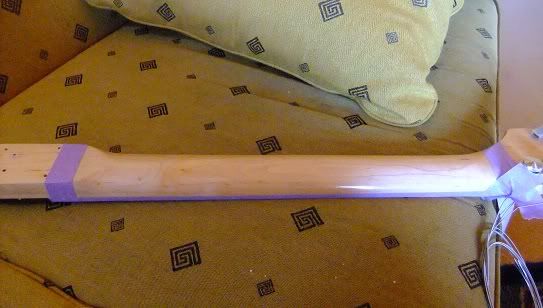 I also taped up the back of the neck, this is to protect the gloss on the edge of the rosewood fretboard. 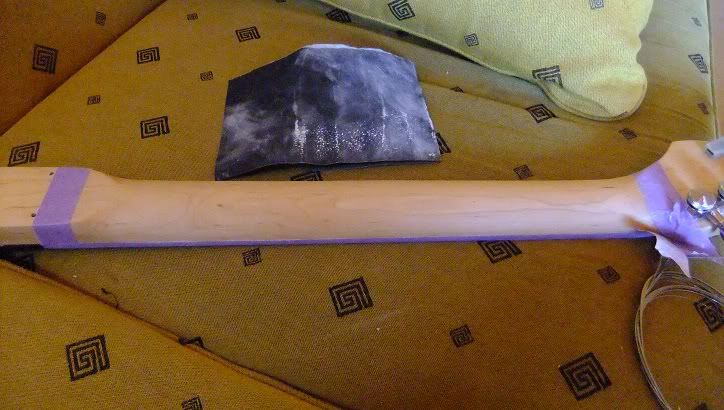 Using wet and dry paper I gently sanded away the gloss on the neck, just the finish, till it was incredibly fast and matt where you are going to play. The neck is quite old but I did quite a bit of playing on it and the shape is ggod and all, the gloss had dulled, but now this part of the neck has no 'stickiness' to it and is similar to the top in a way. The edges of the fretboard are still gloss, like some kind of binding, as is the headstock and other parts of the neck...so just the playing area. ... So, a successful day...it might need another light coat, so will see how tomorrow fares weather wise when the coat on it is completely dry and solid. You do not want to risk a 'rubbery' finish, old guitars often had perhaps 16 coats some times. It's tempting to perhaps try some kind of polish over the finsih as is rubbed in by hand that may more authentically age...perhaps something like shellac...hmmm, any thoughts? I had been thinking that this could all wait till I had other work done to the guitar, but too good a day not to take advantage of it. It is a good idea to have a protective coat or two on a natural finished guitar I think, but not so perfect that any scratches from building things like bridges or HB holes and the like make a mess of it anyway. ... The only real main hardware to come is the trilogy. I have a few options for mounting this. Originally and typically for this kind of thing I was thinking a 'floating' tail-piece mounted on a plate held on with screws and the strap button. But, as this guitar is a bit different, once I get hold of hte device, I may well mount it directly into the top, screws into the tail block and strengthening to take another pair of screws or bolts...the top protected and filling the 'curve' of the top with a neoprene pad...will have to see when it arrives. ... Might be time to make a list for the electronics and get an order in there, draw up a plan and run it by you guys...stand by for questions LOL... |
|
|
|
Post by 4real on Oct 27, 2011 4:15:08 GMT -5
Have not been able to do much today, but was not satisfied with yesterdays finish, so sanded back to smooth but not through the finish and tried a more conventional 'spray' on the top with it sitting flat to avoid any 'runs' and worked out really well. A natural colour with a satin finish and no obvious flaws...nice and smooth, so won't be tempting fate by doing any more.
Scrapped the binding carefully to take off any stray finish and is a nice contrasting white around the edge, washed both the outside and inside of the guitar again and is sitting in my dish rack as we speak...this is the only guitar I'd rinse out in this manner, but been a really handy feature LOL.
I'm not entirely happu with the slightly budget GFS locking tuners...they look cool and seem well made, but...two strings have been 'cut; and I think I will need to 'round off' the holes in them as that seems to be the flaw. This has never happened with my schallers, so disappointed...especially since I found some for only about $20 more than these turned out to be with GFS freight...hmmm...there is a lesson there.
I see that I've been charged today from hipshot, the freight there is steep, but I think it will come relatively quickly and I can move on with the project...
I had better get some kind of scheme for the wiring sorted out so it can be checked here and put in an order for parts.
...
I'm planning on putting sizeable hole for a jack socket plate. In part to gain access to install the electronics and because there are likely to be several output jacks.
I'm thinking one each for mag, piezo and hex perhaps, but I also have a 4 core quality mic cable and looking for ideas or recommendations for a socket that will accommodate these three outs and ground, perhaps even 4 outs just in case I one day do a stereo version of the hex perhaps and I'd run that to a breakout box on the other end or incorporated into a pedal board (it would be good to avoid having three guitar leads coming out of the instrument in performance)...any thoughts?
I had thought that perhaps an emergency passive out for the mag might be an idea, just in case things fail but I have to make a noise you know...though the jack sockets are mounting quite a bit there...again any thoughts would be appreciated
|
|
|
|
Post by 4real on Oct 28, 2011 13:09:22 GMT -5
Well...the hex things were 'looking good' but may have reached some fatal flaws... 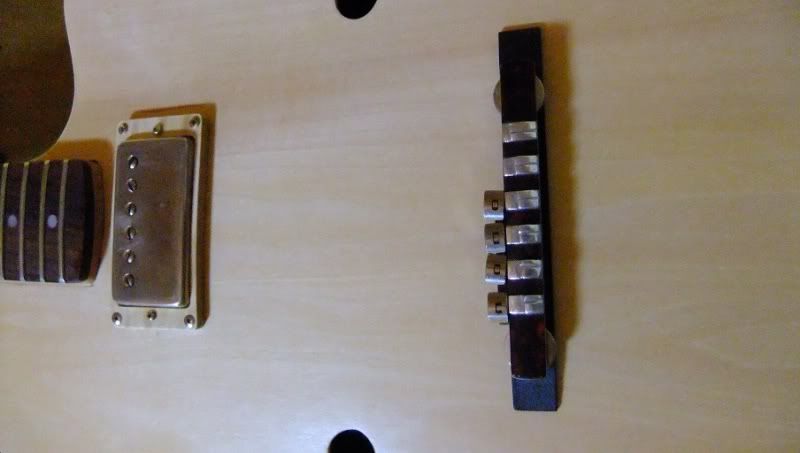 You can see above that the re-wired HB is fitted neatly into a ring aligned with the strings and neatly... And the rest of the guitar is coming along while waiting for parts still...the finish was completed with a final spray to give a flat 'satin' finish...  The end result after sanding carefully for this coat looks pretty professional and has a lovely 'smooth' feel. The colour is natural of course, but fairly well matches the neck...will let it have some sun to age a bit quicker perhaps. The overall look is quite attractive, a sharp white binding separating this natural almost 'unfinished' blonde top on the stark black textured body and sides...very 'two tone' but a good look I think. That look will be echoed in the bridge, trilogy and other parts, black knobs and the like. The tail-piece is winging it's way from the USA and with the amount of postage added, I expect it will not take too long and I will be able to make it fit in to the overall scheme and settle on a mounting of it and test it's effectiveness. I found a nut from the LP project, a black Tusq I bought till I found out they now make white ones (doh!). It is the exact same string spacing but a little thicker...so we will see, but perhaps I might use such a thing to make some kind of 'compensated' nut for improved low fret intonation with open strings. Generally though, the guitar plays well as is and if the conventional plastic nut works, might leave it...especially as the bridge is already compensated and not an easy thing to adjust.  Been some wild wind and now rain, an analogy for what is going on in real life of late...so perhaps a time to not push the project along as much and think about things...and avoid some costly mistakes...still it is a pleasant distraction to have and a good reason to mod guitars in the first place...a bit of creation is preferable amongst the destruction...hmmm |
|
|
|
Post by 4real on Nov 2, 2011 7:22:23 GMT -5
Well, look what came in the post today... 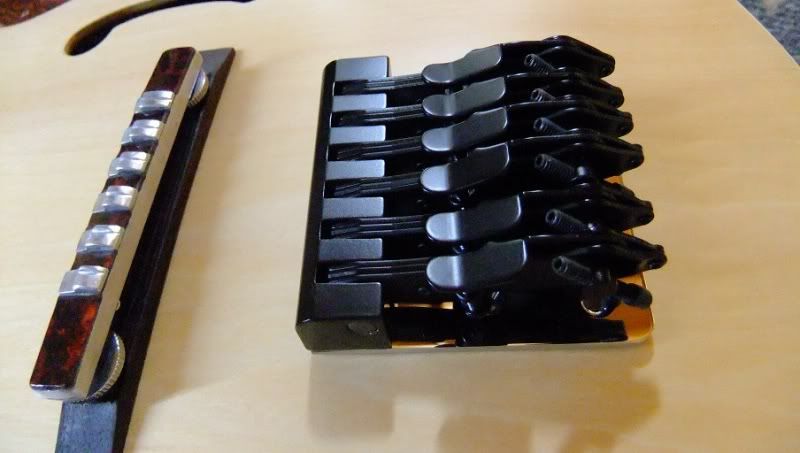 The hipshot trilogy...not as elegant a tail as I ahd designed, but a very high quality bit of hardware and built like a tank. It's about 3" square and sits perhaps an high...a bit 'chunky' and weighs quite a bit. Fortunately, it balanced this light bodied instrument very well... 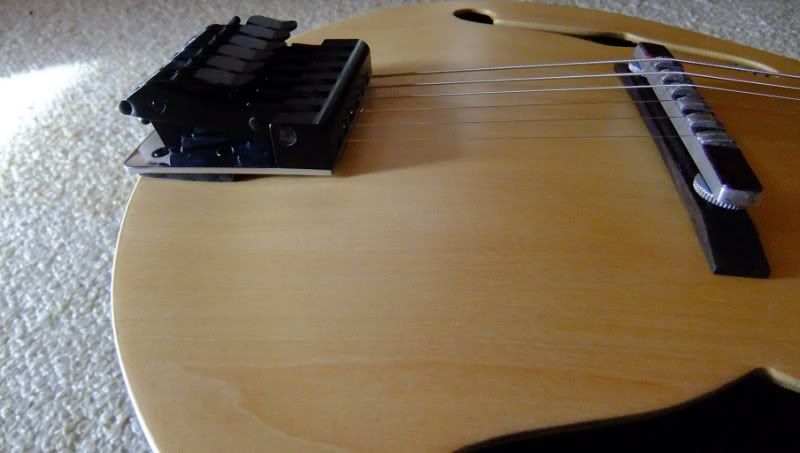 I decided to try mounting it directly into the top, slightly overhanging the end of the guitar so that the screws go into the end block inside the guitar and leaves the tp to vibrate. I also added a cushion of neoprene to protect the top and 'float the forward section about the 'arch' in the tp and aimed at the bridge. 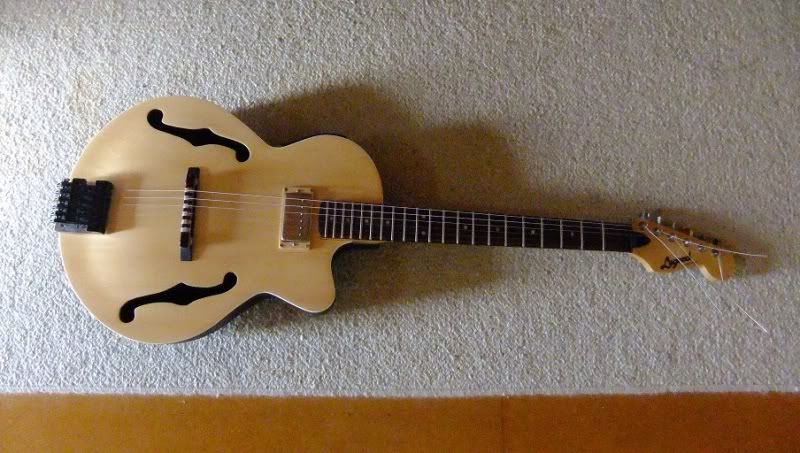 The end result is not bad, will blend in better with the black control knobs. ... The new strings need to be 'broken in and settled' but on this guitar it does exactly what is suggests. Can lower the strings to two other set tunings. So, with a flick of the leaver the low E effortlessly and accurately drops from E to D to C...even while playing the string. I've not decided exactly what tunings I will be using though, possible half steps down which gives a whole range of common tunings. As far as I can see, as long as the string gauge is not changed and the guitar is in tune, once the fiddly bit of setting the set screws, there should be little need to adjust them often if at all. ... Meanwhile, I seem to be getting along well on the hex things...but going into a period of waiting for parts and organising a few things. I've missed the guitar being in a playable condition, it really is a fun guitar to play even as an acoustic! |
|
|
|
Post by 4real on Nov 2, 2011 17:27:44 GMT -5
Pete - for your set up, you wont need much extra electronics, since the piezo is already sorted out. You should put a buffer after your mag pickups (after their volume comtrol), then the blender module (ie 500k linear pot with buffer (ie as I drew it). So theres two JFETs needed, and they are not producing gain - so in fact the circuits can use most types of JFET. As drawn, they will be fine for J201 or 2N5457. With other types, one of the bias resistors might need a different value. John Well, now that the guitar has string on it again, it is time to think about the electronics side of this project....hmmm...still some confusion but I had better get a shopping list together and bring the components all together...so will need some help here... 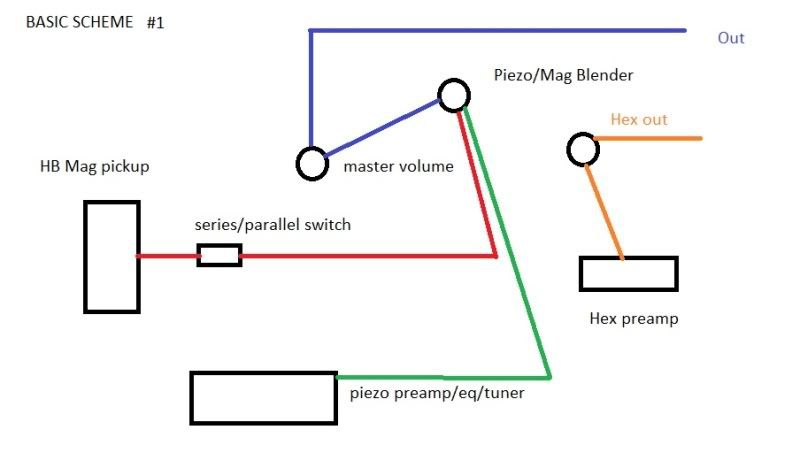 A master volume is critical, both for performance, but more importantly to be able to be able to turn the guitar off...being an acoustic guitar, it is likely to be prone to feedback! The Hex thing has to be separate as the point of this is to have external processing, it's own volume pot with the master should help provide some balance control, adjust for volume when different string pups are selected and turn that off as required (along with the string selector switches) HERE ARE SOME QUESTIONS # How many buffers are required to make this kind of thing happen? # What volume pots? (generally it will run into a conventional guitar amp, occasionally a recording interface) # is it possible to have separate piezo out, mag out and hex out (I'm considering the hex thing to be a separate output always)...as well as an active out for the piezo/mag system...perhaps even an emergency passive Mag only out? Separate outs would allow for different amps or for recording or separate processing options...generally I would anticipate the guitar to be used in mono with a normal guitar cable to a single guitar amp. # an 'emergency 'passive mag out' might be advantageous should the battery go flat or something. ... SO, that is a lot of 'outs' there. I could fit a few on there as anticipating having to create a sizeable panel to access the inside and fit these things and allow mods by replacing the panel should that be required...combining sockets to reduce numbers might be helpful. Adding switches is a possibility to run the outs in separate modes of operation if that would be easier. I am still considering some kind of DIN socket perhaps as a 3 out into a special cable, but as I can't really carry spares and would need some kind of 'break out box' it is an option (would look a lot better than 2-3 cables out of the guitar for performance though). ... As for the buffers...hmmm One for the mag? One for the blender One for the master volume Piezo has it's own, hex will need a different preamp with more gain I suspect so unlikely to need anything there. ... If people (and john of course) have a look over the idea/scheme and make suggestions it would be really helpful so that the parts can be got and the electronics be constructed and tested out. I'd be prepared to buy a couple of different values of things like pots if there is some testing required. Any and all suggestions,comments,criticisms,alternatives and the like appreciated and of course getting things into a cohesive detailed plan.  Summer's coming, and I'd like to get this finished because, well, there are other things to do  |
|
|
|
Post by newey on Nov 2, 2011 18:54:14 GMT -5
All that I can say about the electronics is contained in JohnH's version of his piezo/mag buffer circuit, as posted just now in my Stealth Strat thread. |
|
|
|
Post by 4real on Nov 2, 2011 19:02:02 GMT -5
Thanks newey Looking to use the blender modular things... guitarnuts2.proboards.com/index.cgi?board=schem&action=display&thread=4595 Am ordering enough components to make a few (minimum order requirements on a bit of this stuff) as they are likely to be useful for a few projects over time... Quite how many and how this overall scheme should work in this guitar though is still a bit of a confusion however... thanks though |
|
|
|
Post by JohnH on Nov 3, 2011 14:33:48 GMT -5
Hi Pete.
I think, setting aside the hex system, the reliable answer to how many buffers modules needed is three:
With three buffer stages
The Piezo has its own system (not counted)
1. One buffer after the magnetic output (as module, but no pot)
2. Blender pot with buffer (per the module design) to blend from Piezo to mag
3. Volume pot with buffer (as blender module, but with lower leg of pot grounded to make a volume control.
This will give you an active low impedance output that will run into most types of device
One thing to check: Are you happy with the natural volume balance of the Piezo preamp, as compared to the magnetic pickup. Are they about the same volume, or does one need boosting or trimming so that when ou sweep the blender you’ll get smooth mixes?
It’s not too critical. In my case, I was mixing Piezo with a fairly nutzy mag system, so I balanced the Piezo volume with a mag single coil, and so series combos on the mag are louder than the piezo, but it still works fine.
With this option, the module will work as drawn, but the output pull-down resistor R4 is only needed on the final stage. Also R2 can be higher (to save current) and C2 smaller in the blender stage and also the mag buffer stage.
With two buffer stages
There is a fair chance that you could get away with one less module, by using a 100k blender pot (with no buffer) then going directly to a 500k volume pot with buffer. For neweys design, we are using a 100k blending pot to save a JFET stage (he also needs to preamp his Piezo, which you do not). The out of this will go straight to output, but in your case I’m suggesting you should have a buffered output so you can plug into a mixer line-in. I think an electro-acoustic needs to be able to do that. The unknown with the 100k pot is whether it has enough resistance to fully sweep from Piezo to mag – there could be a bit of cross talk, but I didn’t know if it is significant. In neweys design, this risk is avoided by switching the blend fully to mag, blend or Piezo. The benefit of saving this stage is that there’s a bit less current draw and a bit less noise, though these buffer stages have very little of that, plus one less thing to build.
Extra outputs
You can add these as extra jacks of you want, before the mag buffer to get a passive out, and ditectly to mag buffer and Piezo buffer to get a pure signal. They can be switched or hard wired.
Hex system
Don’t know what this will need yet – it depends what it turns out to be!
I can sketch a circuit or two for the mag/piezo parts at the weekend
Cheers
John
|
|
|
|
Post by 4real on Nov 3, 2011 16:53:15 GMT -5
Thanks a heap john Much as I expected and anticipated...I have ordered parts for a few of these things anyway and might use some to 'active' some of my other guitars perhaps...like the strat, some time. I ordered parts to make a few and with the resistor variation just in case, plus a few different pots.The whole thing can be tested out of the guitar and inserted later. ... The hex thing is kind of exciting though I'm a little wary as it is a lot like the sustainer stuff. In fact the design concept is based entirely on the old 'hex sustainer' things I was exploring back in 2004 and kept secret so I am a bit cautious of letting out exactly what is going on there. I would be prepared to let out some for beta testing and such if interested...but it will be a little while. For my purposes, I am looking to get it down to a single pre-amp with a fair amount of gain as these things are a very low impedance. The testing went quite well, so it is time to 'step up' with something that perhaps lifts the impedance signal a bit. They should be noise cancelling though and very small, particularly 'thin' and generally able to surface mount...similar to the GK pup...but works in novel way and requires no coil winding...always a labour intensive process. I'm thinking of making them as single sting pickups that could be arranged at will...likely 10x10mmx5mm(H). There are lots one could do with such things besides my application. An obvious one might be a 'stereo' guitar with different strings panned to two amps...like ripley did for EVH. Different outputs for separate processing perhaps before combining back to mono...say distortion only on the high or low strings. Or perhaps, if so inclined, a full hex output or internal hex fuzz...who knows. I have interest from people who might be able to make some kind of 'midi' interface. I'm obviously a novice at the electronics side at best, but much of these ideas are not explored I think, becuase there is no easy cheap way to get separate outputs for each string.So, that's what I am working on,how they are applied and refined will require the input of others. But I am fairly confident that something can be done that will serve my needs at least. Unfortunately, many of these things are on a minimum of 50 order...lucky they are not too expensive LOL so there is a lot of trials and errors to make along the way I am sure, probably have to kill a few to get it right. Still, initial testing is positive and the only way to know how such things will go is to take the plunge and follow through and see how it goes. ... Meanwhile, it is really nice to have the guitar back with string on it.Still getting used to the trilogy and a bit of tinkering required to get that all set to tune.Not even sure of the tunings to choose, but inclined towards 1/2 steps on every string...any thoughts as I have always been a standard tuning guy...but that seems to be the most versatile option. So,most of the parts are in the mail, the GF is coming around this weekend and the weather is looking to improve so will give things a bit of a break for a while. Next step is the electronics though. I have some other things that the guitar needs to finish it, I think the trilogy could be integrated better into the look of the guitar...but a bit of time away from it should help I think... Thanks to everyone for their interest and help and the whole forum for giving me the opportunity to work through these things in public so to speak, it would never happen without it I suspect...pete Here is a 'post card' for the day...'Smith's Beach' two weeks ago...  Additional...hmmm...I am not too concerned about the balance between mag and piezo, the piezo's preamp has it's own volume control and there is only the one mag pup, so that should all balance out to taste (no pickup selection). The series paralel HB otion si to try and lighten up the HB sound without the risk of noise that a split might do. Additional...hmmm...I am not too concerned about the balance between mag and piezo, the piezo's preamp has it's own volume control and there is only the one mag pup, so that should all balance out to taste (no pickup selection). The series paralel HB otion si to try and lighten up the HB sound without the risk of noise that a split might do.
Not sure that I have linear 100k pots though, I thought that was moref for the mag, got a few of each and some spare parts about so we will see what works. A little confused about...
Until we hear this thing other than acoustically, it is hard to know what is needed. However, would yet another buffer on the output after everything have a similar effect?
While there is a lot of piezo projects of late and some great work going on, too much comparison between them is likely to be a problem. On mine, there is a complete piezo pre much like treguiers project and perhaps a better comparison.
The hex thing, well for this project the sound of the guitar is the important thing, with as little noise as possible...but working on the design concept pretty hard. The aim is to run the things of very conventional pre amp circuitry but with a fair bit of gain compared to these buffers. I am sure there are lots of circuitry tweaks that will make for a better sound, being so close to the bridge some filtering might be an advantage and there are other aspects that might aid in getting the best out of these particular devices...but trying to keep things simple in that department or I will just get to bogged down and stray into areas I don't have the skills in and only going to frustrate me and progress in the main game for now.
|
|
|
|
Post by JohnH on Nov 4, 2011 17:59:04 GMT -5
Pete I’ve been checking some more into your mixer circuit, and this is what I think you could have to mix magnetic and Piezo:  Basically, its the two JFET version rather then the three JFET, and i think it checks out OK. The two modules that you need are within the two dotted blue rectangles. The first is the magnetic buffer, based on JFET Q1. This stage gets its input from your mag pickup or switching, or from the mag volume control if you have one. It is as the standard module, but no output tie-down resistor needed, and R1 is 56k instead of 33k. 33k will work fine, but if you use the higher value you can save a bit of power. The blender is R4, and it has to be 100k linear. Then the signal goes into the second stage module, in which R5 is your master volume, which is 500k and can be log or linear according to your taste in volume controls. Overall output on the right is from R10/C5, as per the module design. The JFETs are modelled as 2n5457, which is what I use and is available in 5Spice, but J201 should also be OK with no changes The lower part of the circuit represents the contents of your Piezo preamp, so R9 and c3 are implied, not extra things to build. Current consumption for this circuit will be 0.3mA, plus the Piezo preamp. There’s a few things I checked out on 5Spice and by testing: When the blender blends, it does so by sharing the blend pot resistance to each buffer output resistance and then the blend is determined by the resulting ratio. The JFET buffer output resistance works out to by about 1k, so with a 100k blend pot, the maximum blend ratio is 100:1, ie, if one signal is full, the other is at 1% ie -40db reduced. I think that will be OK and plenty to have it sounding across the full range from mag to Piezo. If you were mixing between two very different signals however, Id be a bit more worried and want a larger ratio. The 500k blend pot would be able to do -54db, but with that you’d be up for another JFET stage and I think its not needed. The reason to use the 100k pot here is so that the following volume pot (R5), at 500k does not load it too much. When you sweep the blend pot, assuming two identical input signals, there will be about a 0.5db volume drop at mid blend, which you will not notice, so all good. In the last stage, the issue is to make sure it has enough output drive and the critical part is R6, at 33k as in the module design. If it feeds say a 10k unbalanced line in, it can drive about +/- 1.5V without clipping. With a high impedance input, it could do twice that. I have this output stage on my guitar, so I checked it again going into a 10k load. Even with three pickups in series and strumming excessively hard, I could not get a noticeable clipping so I think its OK. If it was a problem, R6 would be reduced. I also checked the various cap values and I think they are all appropriate – down to below guitar or bass guitar frequencies. Anyway, how about that? cheers John |
|
|
|
Post by 4real on Nov 4, 2011 20:35:56 GMT -5
Thanks a lot for all that work John I actually ordered the components for the module design though most are interchangeable with this bar those tiny caps and such, not sure what I have about there and in my parts things. (I used element14/farnell btw, shipping is free, the site is a bit hard to navigate, a few items 'in stock' were out but they can locate within a week apparently, there are some things on minimum order quantities (resistors in 50 packs)...) Looks like a good design though...will have to think whether I use that or the modules that you originally designed which could be easier to get into the guitar in some ways. ... I'd love it if when the hex things come together if you could emulate something for those things when and should they come together in time. I suspect that a basic preamp is all that is required, possibly some kind of high frequency filter might help. I'll be testing with generic pre-amps, but likely something I might do with chips and such will draw a lot more power than necessary. I'd have to give you some to test out and get an opinion perhaps. The design of the things seems sound and did well in testing, but hoping to increase the impedance and sensitivity a bit and with a more compact magnet array which are on order but should be soon in coming I think. The design is back to more what I originally conceived with 3 mini DIP switches on either end of the pup to select the strings and keep all the wires inside the pup itself rather than running hex out and doing it elsewhere...at least in my application. ... The strings are on the guitar and playing again and will give it some space to come up with some small improvements as the thing evolves. I'd like to improve the install on the trilogy and blend that look into the rest of the guitar as it is quite different than the thing I had conceived and was building (also added a significant amount of weight to the guitar). ... Otherwise, the sun is shining, the GF is on the way, the vacuum is out and I better sign off for a couple of days...on the beach perhaps! lasts night's sunset was a stunner...  |
|
|
|
Post by JohnH on Nov 4, 2011 20:45:10 GMT -5
No wories! Todays circuit is basicly two of the modules put together, with only a very few adjustments. (to one resistor value and to one pot).
The main purpose of doing that was to consider them as a complete system rather than seperate parts, to see if there were any issues. If you have the parts for the modules, the only signifcant other item is the 100k Lin pot instead of 500k, which allows the 500k volume pot to go straight after the blend pot without an extra buffer in between.
|
|
|
|
Post by JohnH on Nov 4, 2011 22:02:49 GMT -5
Just further on the hex system:
When you have a set-up that you are happy with, then you should make a recording with a reference from something known that you want to match such as a mag pickup, both recorded at the same level. Then we could work out how much extra gain it needs.
Will there be 6 of these built in for hex?
If it develops from the tape head idea, then I'd guess something like a mic preamp is the right sort of circuit – doesn’t need a high input impedance but needs lots of low-noise gain.
It may turn out easier to take a passive output from it, and have the preamp in a floor box, at least to test with.
|
|
|
|
Post by ashcatlt on Nov 5, 2011 9:50:40 GMT -5
Just real quick on the multiple output thing:
If you're taking independent mag and piezo outputs after their respective buffers then you're basically taking them from either end of the blend pot. Seems to me like these outs will then have the same crosstalk as seen at the "master output" with the blend turned all the way one way or another. At -40db, probably a non-issue, but worth mentioning I think.
I guess I wonder how a load on one or both of these independent outs will affect the blending action, though...?...
|
|
|
|
Post by JohnH on Nov 5, 2011 14:37:19 GMT -5
Ash - agreed.
i wouldn't think that normal loading on such extra output would affect the blend. The piezo output should continue to do what it was designed to do which was drive a line input. The mag buffer that I suggested would have plenty of output to also drive a guitar amp directly, though when I increased its output resistor to 56k to reduce current, it then may not have quite enough to drive a line input - so keep it at 33k if that is wanted.
I think the most useful extra output would be just a direct passive out for the magnetic pickup. It provides a no-battery failsafe, and you can set up electric/acoustic stereo mixes across two amps. If for some reason, it is essential to run the passive mag output into a mixer, just put a pedal with a buffer in between (eg any Boss pedal).
i want to add this extra output to my own guitar, and i did mock it up to test it. If you get separate piezo and mag sounds, they absolutely sound like two separate guitars because not only are the tonalities different, but there are phase differences too. I think that would be a very useful thing for a solo performer or one-guitar band.
John
|
|
|
|
Post by 4real on Nov 5, 2011 17:36:51 GMT -5
Thanks guys for the great discussion here, not a lot of time but come back later on these things.
Yes, the potential for running it in stereo or even triple with the hex system is a good one. The hex system too could be run as a bridge pickup with all coils one...so there could be further mods down the track.
I am designing the "hex' system as individual one string drivers so they can be put together for any instrument...so 6 for a guitar perhaps, 7 string guitar, just the bass strings,8 strings, 5 or 4 string bass perhaps...
There is a few reasons for that, but one is that my appplication of such a device at this time is different from anothers. For this guitar, all the pups will be wired in parallel I expect and the switching contained in the structure of six, permanently wired but with a mono shielded out to a pre-amp for the lot. Some one else might want 6 individual outs and separate pre-amps all round.
Generally I anticipate using the thing with a conventional guitar amp, perhaps two and that the hex will be used in various ways. Eventually perhaps a small PA would cope better and produce a huge sound...but this really is a 'concept guitar' as much as anything...there is still a bit to refine.
I will be able to test everything before installing and there is plenty of room to play with, though tricky to get into the guitar. The distance from top to bridge is about 20mm so plenty of room to surface mount the hex and refine that completely outside the guitar till I am sure it works and is a worthy addition to it.
I had wondered about the phase between piezo and mag and if a phase switch might be advantageous is some way. I intend to hide the series parallel switch inside the f holes and could add another easy enough.
I had thought that the modular approach is not a bad one in this instance than a whole board, the tiny circuits could be built onto the back of the pots and perhaps shielded with little cabling between modules and no distance between the circuit and it's pot...feeing up the location of the control knobs too and could make things easier.
I am concerned about noise too, but it will be very hard to know what I am dealing with till things are built. My passive guitars are very quiet and so a bit spoilt perhaps...but I would want to avoid a lot of 'background hiss' and such if any.
The outputs, I am still not sure of, but these are all good thoughts and will test a few things and we can trouble shoot solutions I guess. I had thought perhaps a little switch on the output of the mag for passive/active...tricky to know really as there are three outs effectively and two needing to be combined for general use. I'm stil not quite clear in my mind of all this, but the intention is an oversized access plate where these outputs can be mounted in the usual lower bout location...if need be this can be replaced with modded versions till things are right and no real harm will come to the guitar itself (such as excess holes drilled in it!)
Ok, got to run...but again thanks, everything helps...
|
|
|
|
Post by 4real on Nov 9, 2011 4:32:05 GMT -5
Still waiting on parts, but need to shore up what I am trying to do before I can do that...so got a bit of time to learn a draw program due to a new computer earlier in the year... So here is a preliminary diagram for discussion and filling in the blanks... 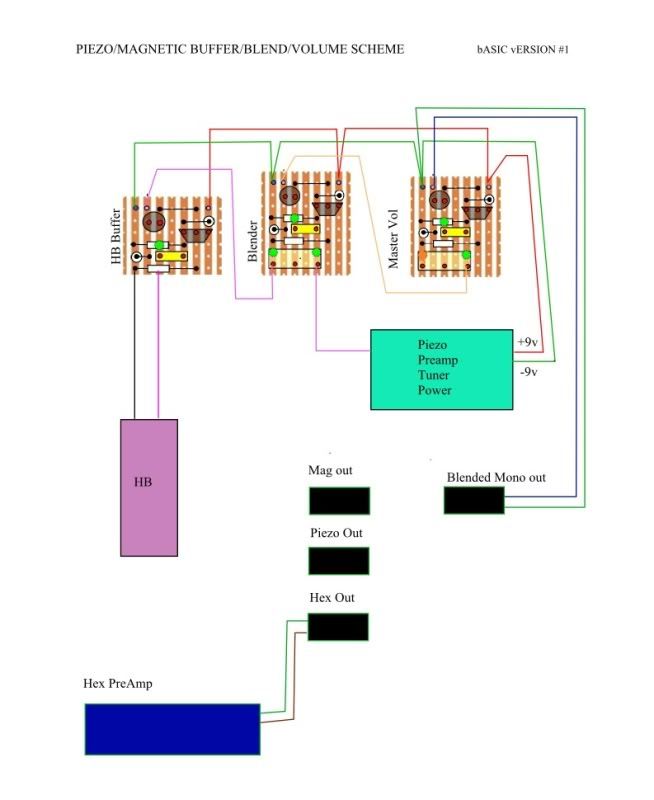 So here we have a buffer for the mag, a blender for that with the piezo and a master volume control ... Additional controls are likely to be a series parallel switch for the HB to lighten the sound perhaps without risking hum from splitting. Q; Would a phase switch on the HB mag pup do anything or be advantageous with the piezo system?I am considering a tone switch on the HB as well, perhaps a three way with two tone cap sounds...kind of a dark switch rather than tone knob hiding in the sound hole. I've left these details off for clarity...so the hb goes to a buffer...and on to the blender... ... The piezo is working exceptionally well in testing...so the output will go to the blender...the output of the blender is a mono output of the mag and piezo systems ... The output of the blender goes to a master volume control...then on to a mono blended output jack. This is likely the most used output on the guitar into a conventional guitar amp. ... I've put in the proposed hex system...at the present time I am looking at a simple mono version with selectable string switching to a preamp and it's own volume control. The intention is that this system will always be used with some kind of processing and perhaps mixed back together on a pedal board...I suppose that will be the next project....hmmm...more buffers perhaps? ... So there are lots of questions here... Q; Does this diagram look ok so far, forgotten anything? Q; I have a few pots, but it sounds like 100k Lin in the blender, 500k Log for the master volume? Q; I might need to include a power switch? Q; are the piezo/ mag systems going to be possibly out of phase, is that something that has an 'effect'? And yet more questions about the outputs of which I have only drawn in a mono blended signal... Q; any thoughts or suggestions? Q; in a recording situation or other situation (PA or multiple amps), how could one get separate outputs? Q; Should any of these be stereo? Q; Should/could one use switches to change functions on the outputs to limit numbers? Q; should I consider a combined output including the hex with a 4 core cable...should that be to separate phone sockets into these outputs, or use a special connector...if so, any suggestions? Q; Should I have a passive mag out (or just to always be sure of a spare battery? If so, how would one arrange that? ... The output section seems to be the most vague and need the most consideration, but there could be any number of options or suggestions while I am waiting for parts. Most have come in, but some are on back order, but they should not be long. ... In order to do more of the 'woodwork' side of things I need to shore up the output side of things a little so I can cut the output hatch which will hold all the outputs and allow access to install the electronics...still tricky as no opening will be big enough to get one's hand in there... Some work that needs to be done on construction is to reinforce under the trilogy tail and perhaps make it blend into the guitar a touch more. I may even attempt to brace the top to the back (something you find in violins and worth an experiment perhaps) to see it that helps the multi tuning system. I am also thinking that I could do something similar to the oversized truss rod cover to add mass and stiffness to the head stock in the hope of improving tuning stability and sustain and solidity of tone. ... So, lots of things to consider. I also got a delivery of the magnets required for the hex project, but still waiting parts there. I have started construction and with some help here, devised a cleaver scheme to wire and switch them in series that is neat and reduces wiring, but it will be quite a bit of fine soldering and wires internal to make that happen. So that tandem related project is still in the works and in waiting. The weekend weather was great, but this place has many changes and just gone through a bit of a wild thunderstorm and rain and now cold...go figure, form 30C to 12C in no time at all...  |
|
|
|
Post by ashcatlt on Nov 9, 2011 13:26:00 GMT -5
Q; Does this diagram look ok so far, forgotten anything?Looks cool to me, assuming the vero layouts are sound to begin with. Q; I have a few pots, but it sounds like 100k Lin in the blender, 500k Log for the master volume?That's what JohnH is suggesting, and I would defer to his judgement without actual testing. You may find that the 100K doesn't give enough separation - too much bleed at the extreme settings from the opposite input - but in this case you probably won't notice. Q; I might need to include a power switch?Most active instruments use the old "stereo jack trick" to supply power only when a cable is inserted. Is this good enough? You'd want this on the blended master output, of course. Q; are the piezo/ mag systems going to be possibly out of phase, is that something that has an 'effect'?Well, without testing you've got a 50/50 chance.  I'd imagine there would be a noticeable effect when the two are blended to roughly equal proportions. I don't know of anything like the screwdriver pulloff test for piezos, and wouldn't know how to correlate the results to those from the mag. The best way to test is going to be to record the output from each to a separate track on your computer (or opposite sides of a single stereo track), hit a note with a good sharp attack, and inspect the waveforms. If you've got a phase switch it's a moot point... Q; Would a phase switch on the HB mag pup do anything or be advantageous with the piezo system?It'll do something. Whether you'll like or use what it does is a question only you can answer. Q; in a recording situation or other situation (PA or multiple amps), how could one get separate outputs?  Sorry, just not sure what you're shooting for here. Q; Should any of these be stereo?A stereo jack to supply power on the blended master is a good idea (per above). I'm thinking, if you're willing to add a couplefew jacks, it'll be easier to run independent outs via standard TS cables, rather than TRS output which would need to be converted somehow before it gets to any typical input. Q; Should/could one use switches to change functions on the outputs to limit numbers?Could, yes. Should depends on how you intend to use it. Q; should I consider a combined output including the hex with a 4 core cable...should that be to separate phone sockets into these outputs, or use a special connector...if so, any suggestions?Again, I think that if you can get away with using standard guitar cables you'll be better off than being forced to carry special cables and/or conversion boxes. On the other hand, it's starting to sound like you're going to have a whole snake hanging out of your guitar, so... Q; Should I have a passive mag out (or just to always be sure of a spare battery? If so, how would one arrange that?I think a passive mag out is a pretty good idea. Aside from providing an "emergency" output in case of battery failure, it also makes it impossible for the piezo output to bleed through the blender and end up in this signal. This would just be a jack in parallel with the buffer input. I'm thinking it might be a good idea to use a switched jack here, so that plugging into here will break the connection through to the buffer and blender arrangement. Probably ground the input to the buffer at the same time, if possible. This way the blended master would be converted to a separate piezo output and you'd be able to run each through it's own effects/amps/whatever. On the other hand, you could probably just turn the blend knob toward the piezo and get essentially the same effect - assuming we're getting an acceptably low amount of bleed through. If you end up going with a multi-core cable to some sort of floor based breakout box, you could supply power from there, and eliminate the need for batteries altogether. I'd probably still want some way of getting an output without that special crap, though.
|
|
|
|
Post by JohnH on Nov 9, 2011 14:33:45 GMT -5
I agree with ash. The module wire-up looks fine. If you want three active modules, then you can use a 500k linear blend pot, and you will get about a 500:1 separation. My suggestion with a 100k was if you didn’t want to build the active part of the blender module, just the pot, then it would need to be 100k lin and the wiper of the blend pot would feed to the input of the volume module.
The advantage of a two module version is lower current, and fractionally smaller noise and distortion (measurable in lab only). The three module version has better separation, but again I dont think you will notice.
My system on my Strat stops at the blender module (no master volume) which is then the output. It has a 500k blend pot and I definitely get the full sweep from mag to Piezo with no noticeable bleed.
You at liberty to increase the 33k output resistor on all but the last module to 56k to reduce current
I think the only extra output you need is a passive mag out, unswitched. Use screened wire to wire it to ground and to the pink wire of the HB. If you don’t use it, it does nothing, and if you do so, it does not affect the blend, which you can continue to set to whatever you wish. So withthose two outs you can have a mag and a pure Piezo if you want.
Have you determined that the volume level from the mag and Piezo are reasonably similar, such that you will be happy to blend between them? You should check that first with a test – if something needs a boost or a pad it can be added.
I think you should allow to swap the phase of the Hb, but theres no way to know if you will have to until you test. I think piezos and magnetic pups are not necessarily in or out of phase, they may be 90 degrees different. However, once Id finished mine, i found I had to swap all the mag pups to get the piezo blend to sound right. I doubt you will want to be switching phase in use however. Its better one way than the other.
Cheers
John
|
|
|
|
Post by 4real on Nov 9, 2011 19:30:06 GMT -5
Thanks guys...
I thought I was on the right track with these things and will be testing everything outside the guitar before installing things. Still waiting parts.
A bit reluctant to cut another big 2" sq hole in the side of the guitar LOL...but it has to be done to get in there and to mount all these outputs however they might turn out...perhaps later today...I need to get further into the guitar anyway to provide more support for the trilogy for that to be reliable on this guitar.
I thought the phase thing might be an 'issue' so will be able to test to what sounds best and go with that without 'switching'.
The phone plugs may be sufficient for a multicore cable, breaking into three phones on either end rather than extra sockets and odd connectors and be 'safer'. In a recording situation it would be no harm to run three conventional leads if required...not so good in performance. I am anticipating that the current draw is going to be low and the system reliable enough to trust to just carrying a spare battery so possibly over concerned on that score anyway.
Perhaps the Hex thing might draw more power than I'd like, but nothing like a sustainer. Potentially I could run it off a separate battery if it is a concern and be switched off when a cable not plugged into it...it is a separate system to the rest of the guitar, a cool concept but yet to prove itself in design or performance...so that will come a bit later
I'm sure that things will become clearer when I get everything here and built and nut my way through it all.
I appreciate the help and credit all concerned with making one cool guitar happen...taking a while and a lot of work and thought, but shaping up well...so a big thanks to all and the forum for providing even the possibility of such work to occur and succeed so well.
|
|
|
|
Post by newey on Nov 9, 2011 23:25:37 GMT -5
We had a similar debate regarding the use of a switched jack on my stereo Tele project (Still gotta make time for that project now that the 4Caster is finally done . . .). Ash suggested, and I recall a general concurrence on this, that it would be best not to have a common ground if the signal was to be split into two separate amps.
So, I'm using a switched jack, so with one cable into jack "A", I get both pickups into one mono output; plug into the second "B" jack and "A" gets the neck pickup only while "B" gets the bridge only, with separate grounds for each channel.
Of course, your mag/piezo issues are a bit different, and an active circuit vs. a passive as well. But it occurs to me that a separate parallel output is fine if you just want a failsafe mode for battery failure, but might cause issues if the goal is to run into two separate amps for piezo and mag, for the same reasons as on the stereo circuit.
|
|
|
|
Post by 4real on Nov 9, 2011 23:33:28 GMT -5
Good point sumgai, and I was just about to push the button on a matching set on 4 jack sockets at that moment...hmmm
I had some doublts in the background on the possiblility of ground loops in a multi amp situation after much to-do and expense with those issues on the computer and monitoring situation.
Will stereo jacks do such a thing? Or do they need to be actual swtch jacks?
If the guitar is all earthed through the same power and ground, can they really be separated? Does the fact that everything is going through buffers address the problem?
Ohhh....what to do...I have a few different jacks about, but it would be good to have that sorted and ordered so I can be sure of the hatch before taking a saw to the instrument!
Still, better to know in adavance, I feel I am going into this with half a plan as it is LOL.
An answer sooner than later would be appreciated...i was literally making my mind up and hovering over the button to order when I got this email alert!
|
|
|
|
Post by newey on Nov 10, 2011 0:17:27 GMT -5
No, a TRS jack is just 3 conductors, with a common ground for the 2 channels. That's fine for stereo cabling in a stereo amp, but to run into 2 separate guitar amps might cause some noise issues and was better avoided, or so the thinking went. No one was saying it was guaranteed to be a problem, it was more of "possibly a problem, so avoid it if possible".
So rather than take the chance, I designed it for a switched jack. This has two switched and two unswitched connections, inserting a plug barrel changes from the one set to the other set.
These are generally sold as "headphone jacks", to be wired so that inserting the phones kills the speakers.
|
|
|
|
Post by 4real on Nov 10, 2011 0:56:11 GMT -5
Thanks....just did a bit of a search through some boxes and found three stereo plus switch sockets like that...some even match. That should get me by the testing stage. It occurs for me to to take my own advice and in stead of building a finished hatch door...make one from cardboard for testing then use that as the template for the final thing. The hatch is also a failsafe...it provides important if limited access while allowing it to be completely replaced in the future should I require more tinkering... I am surprised no one has suggested balanced outs and all that. It would be best if the guitar can take on a range of options. In reality most often it is likely to be used with a standard amp out of the blended mono output. The hex though needs to go through some kind of pedal and then to the amp or another perhaps. One day, perhaps a mixer and compact PA and Im might need a simple mixer. For now, got to use the options I have. Generally a fender HR deluxe which i was pleased to find made a great sound with the piezo pup. I still have my old SS Roland GA60 which is a clean amp with graphic and aluminium cone 12" and survived service and never has broken down after all these years. Both can run with a 15" extension box and sounds great together, particularly the roland, for bass and has a kind of natural crossover kind of thing to take on a wide frequency range. Another amp I have is a little 8" 15 watt battery powered two channel ashton. Recharges and good for a few hours work and a neat little 'wedge'. With such an amp, and obviously the hex bass is a little much for it, there is a good little instant low powered amp that does not even require power.  It is a surprising amp for what it is and perfect for sitting down with the guitar in say a sunday market and playing for a couple of hours  ... I was reminded that there are other 'features' of this concept guitar that I have not really discussed...the plastic body is impervious to weather changes and scratches and is quite strong and comfortable and with locking tuners the strings can come off, roll up, and the neck detached with 4 screws in minutes and so will travel well in small spaces if desired or needed and put back together in no time. Cool, and as an acoustic, it is even it's own battery free practice amp! |
|
|
|
Post by 4real on Nov 11, 2011 3:23:52 GMT -5
Ok...got a bit of stuff done on the guitar...want my dining table back LOL... Still waiting for the electronics but there are things that needed doing and refining before that can happen anyway. Importantly I needed to make an oversized hatch for the outputs so I can get inside the guitar and reinforce things to better install the trilogy. This is perhaps the first 'acoustic guitar' that integrates the trilogy but in some uncharted waters to some extent...anyway...some pics tell the tale for today... 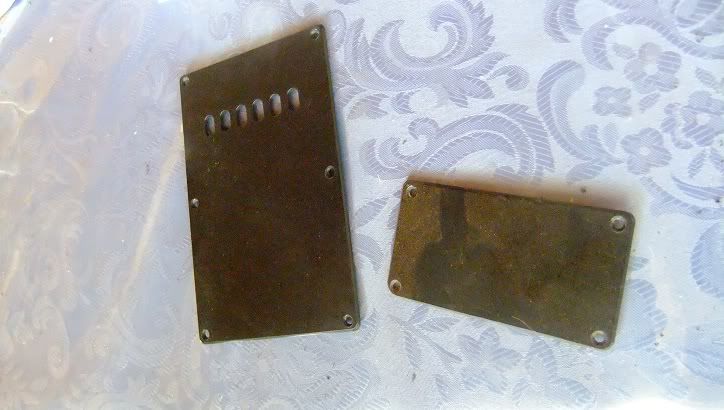 Cut a hatch cover that matches the body from an old cheap strat back panel Moved the trilogy to a better location and installed some red cedar to take the screws seen here in the hatch opening glued in place.  The idea of hanging the trilogy slightly off the end of the guitar was not a 'bad one' and stems for the ideas I was trying to make myself but it was a bit of a PiTA with the trilogy and looked a bit of an incompetent install. The trilogy is mounted by two screws and the bass plate is exceptionally heavy (1/8" thick brass I believe) so it needs only be supported pretty much at these points fair way back in the unit. 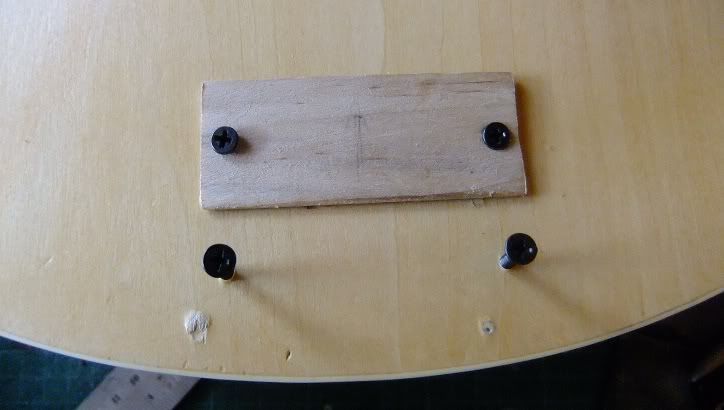 I moved it up but still far enough back to hide the old screw holes and to hit the heal block on the back screws, installed a block inside for the front screws and shaped a bit of wood to 'float' the unit above the top and curve in it... 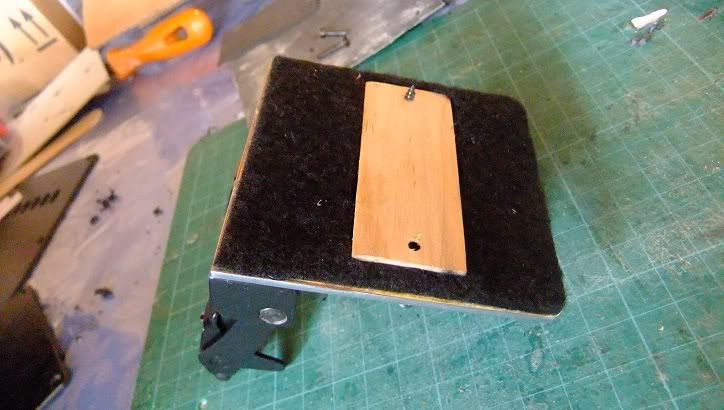 Using double sided tape, I covered the bottom in felt cut to shape and cut out around this piece of wood so it will sit solid... 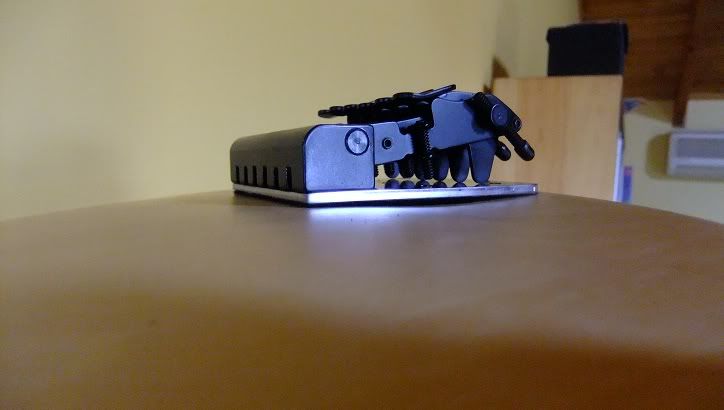 The end is that it is rock solid to the top and the mounting hidden and the top protected by the felt. Although the whole unit seems to be hard on the top, it is held on just forward of the heal block...this allows the top to vibrate without the more traditional approach to floating it from an attachment at the back of the guitar. I like this better and I am trying to make this thing a little 'different' as well as working effectively and pleased with this solution... 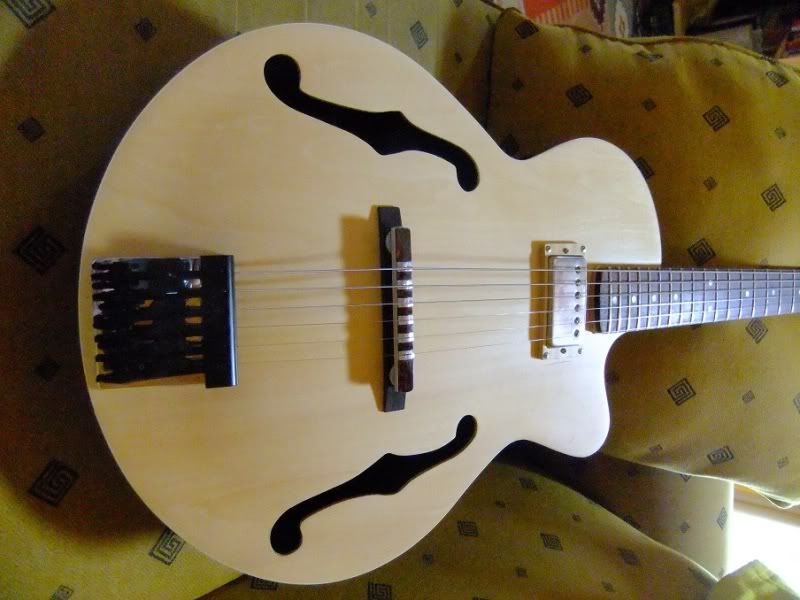 The end result is pretty good I think and the oversized hatch pretty inconspicuous... 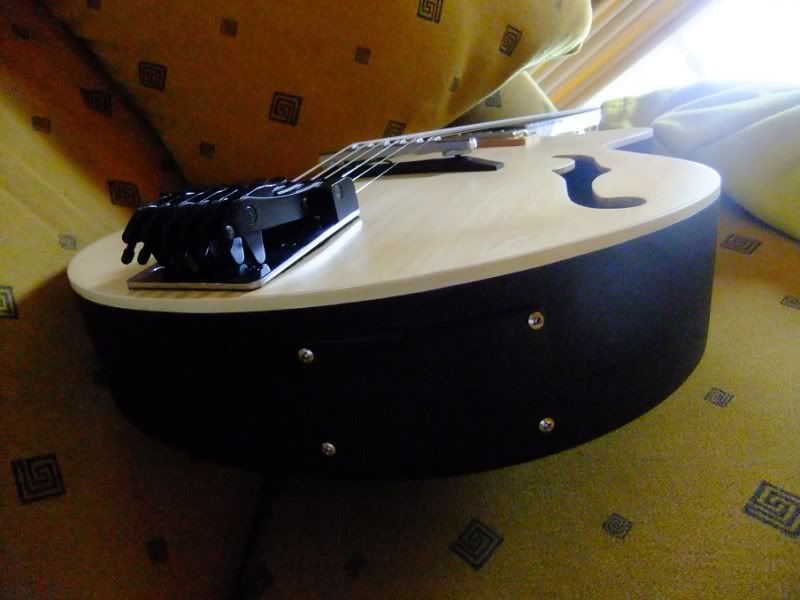 A few more pics of the project from today to come...standby...LOL |
|
|
|
Post by 4real on Nov 11, 2011 4:32:34 GMT -5
Ok...so just a few more details... 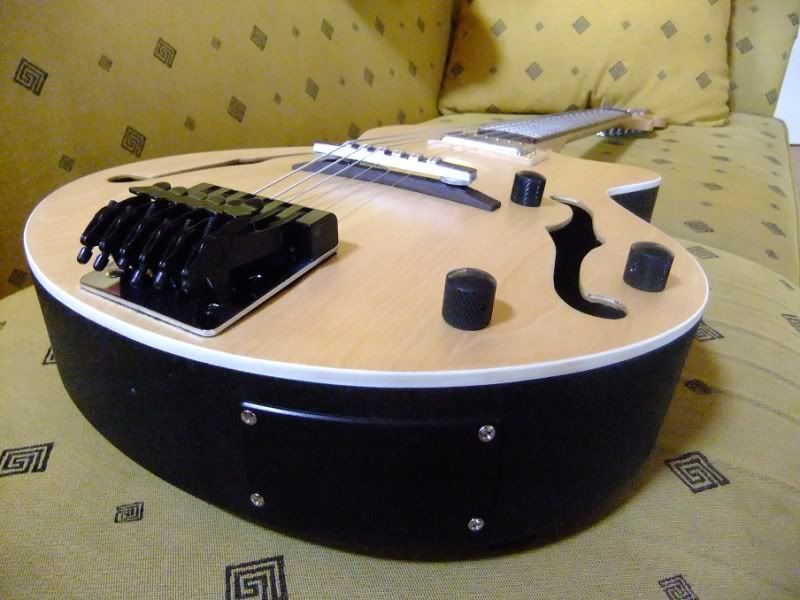 A better look at the new 'hatch' for the output and getting the electronics into it...also, how the trilogy fits in with the control knobs that kind of balances things out a little. 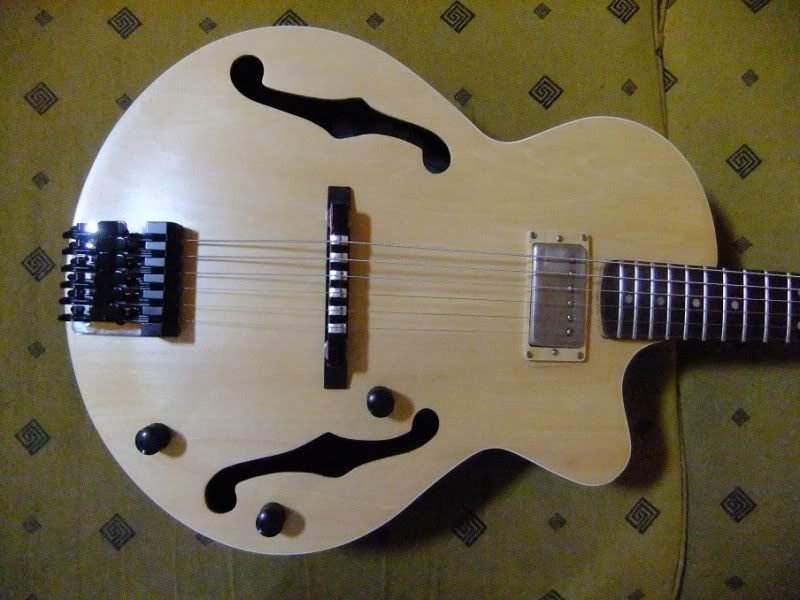 Another with the 'knobs on'...volume within reach, lower control blenc, back control for the hex volume. ... Part of this design is an attention to 'ergonomics' and why this guitar feels great to play...  This pic shows the side piezo controls (bass, middle, treble and presence plus volume control and tuner). The 'shape' of the plastic back is shown...it is only about 2" thick at the neck join where your belly tends to go and the neck feels as if it is wrapped around you. Something that took me a whle to get used to on fenders after playing a gibson for some many years...only more so. The fairly extreme back angle I built into the neck pocket achieves this 'wrap around feel'. It also allows the bridge to be quite high. Arch tops work differently than flat tops, the top tends to bounce and work best when there is that 'suspension bridge' kind of effect...think of a cello or violin. You can also see that although the trilogy is a hefty piece of hardware, to the player it is on a plane with the bridge and less 'stuck on' as it typical of this device. The guitar is not as big as a typical arch top, perhaps like a parlour style size...so ergonomic seated or standing with the playing area away from the body and the neck pulled in closer...ideal for finger-style work, but it is fairly versatile for all kinds of playing. Far more comfortable to play than most solid bodies feeling substantial without being 'huge'...if it feels good, it is good! ... The following pics may give a better idea of what the trilogy is and how it works...  Pics in the above post show the trilogy in a locked up position, standard tuning...you use the Allen keys to 'tune' the throw of the tuners to lower tunings...above it is set to open G by lowering the two E's and A string down a tone...in this case, that is the lowest position on those levers. 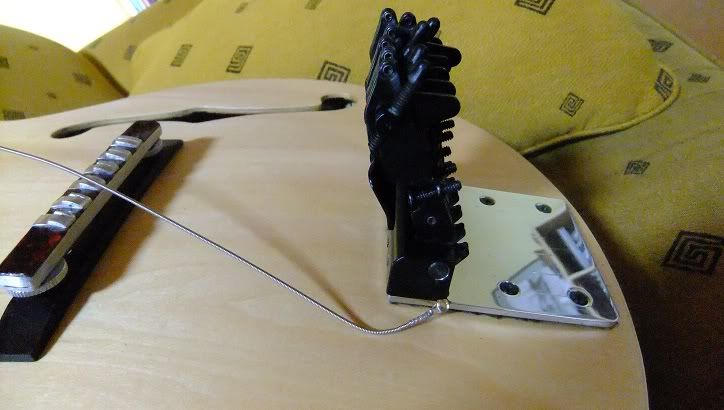 The above pic shows how you string things up. Lift all the levers up, locate the ball end into the 'hooks' (noticed the soldered string), lower the lever and tune up...locking tuners really help with the process. ... So a lot of work in this thing and a lot of thought into all the aspects to try and make it kind of unique...although it has a lot of 'traditional aspects' it is quite innovative in many aspects and a lot of the 'features' are hidden but immediately apparent when you have it in your hands. Still excited by the instrument but the longer it goes on, the more reluctant I get about cutting hole in it or screw holes. It was a good recovery on the trilogy (the previous mounting was temporary regardless) to cover the screw holes and sometime you do need to try things and be prepared to make a different plan. Thankfully, most but a few cosmetic things and tweaking is to be done on the instrument itself...might do something to reinforce the head to further stop flexing for the tuning to work better though I expect quite a few improvements by the improved install. Otherwise, ready for the electronics when the caps arrive...the hex thing, well that is for later too, probably suspended from the bridge and I found a nice preamp that might work better than the ones I've been using.The tiny string selection switches will be built into the pickup itself...well at least, that is the plan. I am expecting a few problems with the electronics too, but I can test everything outside the guitar and install when everything is working right and the problems solved...in particular I am a little concerned about the possibility of ground loops with a multi-amp situation....but we won't know I guess till things are tested... Thanks for the interest...for those interested in the island...  As I am typing this stuff, I thought, hmmm, why has the house turned red...and the whole sky was lit up in reds and pinks...so there you go, sunset in real time! They are not all golden and even with a few clouds about it's hard to get sick of seeing them... |
|
|
|
Post by JohnH on Nov 11, 2011 16:39:54 GMT -5
I was just thinking a bit more about the earthing and phase issues if you go to two separate amps. With earthing and ground-loop issues, you should be fine if you plug into two amps both powered from the same wall outlet. A likely scenario where that may difficult to achieve might be if you want the mag to go to your amp, and the Piezo blend to go to a separate mixer or venue PA system. If that type of scenario is likely, a DI box with a transformer could address it – best placed on the active output. Another solution would be to have a dpdt switch on the guitar to completely disconnect the mag pup from the blend (ie, switch both hot and ground wires), so it makes a separate circuit. You’d lose the blend though and it would be only Piezo on the other out.
On the phase issue, I said before that once the phase is right, I guess you wont want to change it. But what if the mag and Piezo end up going to separate amps which are not in phase? Eg, if one amp has one more preamp stage than the other, then the phase could be reversed. This can also be fixed using the external DI box, if a guitar-mounted phase switch is not otherwise wanted.
|
|
|
|
Post by 4real on Nov 11, 2011 18:17:00 GMT -5
Good points john
I have had to get DI boxes before and have a 'ultra-G' ( to stop ground loop between amp and recorder) and a hum destroyer in my computer monitoring system (monitors and interface)...so perhaps I need even more. I really don't want to hike around a bunch of outboard gear though...hmmm Neither have a 'phase switch' on them...grrr
When I test things out, I will try a phase switch perhaps and see what it does...if it has uses, can leave it in, if not will pick the best sound.
I dare say I could disconnect the hot and ground and connect to a separate out with a 'passive' switch as these things are dpdt.
I am not overly concerned about adding such switches as these will be hidden to the side of the f holes. Building the metal plate to accommodate things though for the install proper needs things shored up.
These are the kind of things where problems are going to occur and perhaps again with the hex system.
I don't think I will ahve problems making the circcuits and wiring, but the functionality seems to have a lot of compromises and fussyness for my liking.
...
I kind of have in my mind that there are surely plenty of stereo systems about, mics or mag pups and piezos...treguiers project seemed to work but perhaps not stereo.
The blend into mono is ok, but is there a way to make the blend go to stereo so the blend can be adjusted from the guitar to separate outs in active mode?
The passive out is only really for an emergency, I am content with things being active generally. In fact, I'm not too happy with the master volume being bypassed and a problem in passive mode without this control (I might need to control feedback or turn the guitar off).
In a situation where I am going to separate amps and such, it will be an active guitar and will want an active out for both piezo and mag...
So, a bit concerned that this scheme fails on a lot of these fronts and the end result will be sub par and a constant frustration. The project is kind of too important to design in flaws and frustrations and work sub par.
But, still waiting for these caps, so perhaps we can address things a little before I start making things and drilling holes, even if it requires some significant modification to the plan...hmmm
Thoughts...are my requirements unclear?
|
|